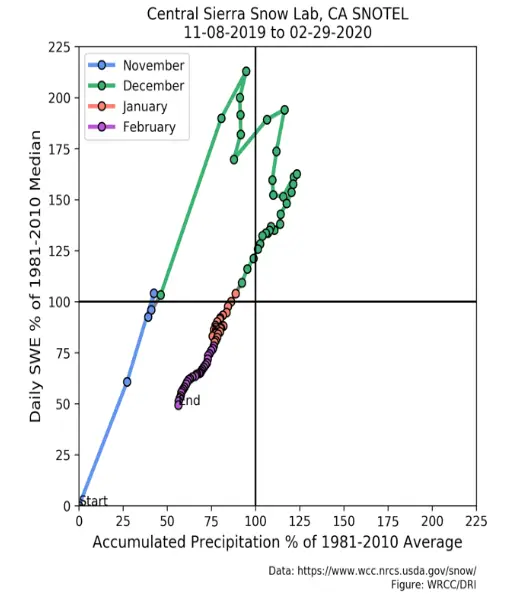The value of natural reservoirs threatened by climate change on the west coast
The word “drought” brings up many memories and emotions for me. I grew up in suburban northern California, which meant skiing weekends in Tahoe and hiking in the Sierra Nevada in the summer. California is a land of extremes with enormous, wet storms blanketing the mountains with a heavy coat of snow in the winter, and extended periods of sunshine and warm temperatures (indeed, a seasonal drought) during the spring and summer months.
Like other Californians, I grew up well-familiarized with drought. It meant the creek in our backyard was flowing low and warm; it meant the air was smoky from wildfires; it meant you had to walk half a mile across the dry reservoir bottom of Folsom Lake to get your feet wet after a run.
I became fascinated with snow, not only for the incredible feeling of swooshing down it on skis but also for the powerful natural resource it is. In the Western United States, reservoirs are incredibly important for supporting agriculture and communities with water supply during the dry spells that can last weeks or months or years. But the snowpack is the reservoir that never needed building— it slowly “fills” during the winter months with each new storm, storing water in its frozen form (we call this snow water equivalent, or “SWE”). In the springtime, as the snow begins to consolidate and melt, the snowpack slowly “releases” water downstream.
In the Western U.S., 75% of the water supply comes from snowmelt, but the benefits of water storage in a seasonal snowpack go beyond water supply. Water released slowly from the snowpack can percolate deeply and thoroughly into the soil, which acts as a secondary reservoir. Think of it as nature’s drip irrigation system: soil moisture and groundwater storage can replenish, and water is available for trees and plants to sequester and store carbon during the growing season. This also means that streamflow can be somewhat maintained by groundwater (i.e. baseflow) during the dry summer months, sustaining fish populations, water supply diversions, etc.
Impacts of Snow Drought
Of course, there is some natural variability in snow accumulation, but what happens when there is an abnormally low amount of SWE stored in the snowpack come spring snowmelt? In the last few years, the term “snow drought” has been developed to describe this. Snow droughts can be driven by below-average precipitation (dry snow drought) or above-average temperatures (warm snow drought), or both. In the case of California’s 2012-2016 drought, it was hydrologically driven by all of the above.
The 2012-2016 drought has been called a harbinger of what is to come. Studies project that California’s climate will become even more extreme and variable under future climate change scenarios, which according to other studies, may already be playing out. While precipitation trends across the Western U.S. are relatively uncertain and variable, trends in temperature are projected to continue to rise. This means a higher incidence of warm snow drought in mountain ranges across the West (and other communities and ecosystems reliant on snow for its water supply), including the Sierra.
The most obvious driver of a warm snow drought is more precipitation falling as rain rather than snow. In other words, in an overall warmer climate, the elevations at which snow typically falls will experience rain instead. A higher snowline will decrease the total areal extent of snow cover, decreasing the total snowpack SWE storage. It will be as if we replaced a portion of our drip irrigation system with a hose that runs at a high intensity and for only a few seconds at a time.
Another driver of warm snow drought will be the effect of rain-on-snow events. Some elevations will experience both snowfall and rainfall events. When warm rain falls on snow, it increases the energy of the snowpack and can cause rapid melt, depending on the magnitude of the event. This not only can result in massive downstream flooding but can also act like a “release” of water from the snowpack reservoir, resulting in decreased SWE and water available for melt in the springtime.
This means less water available to percolate and recharge soil moisture and groundwater, less water available for mountain terrestrial ecosystems, and less water available for runoff into streams and rivers. The projected shifts in growing seasons, evapotranspiration, and soil drying are more complex, and studies are currently trying to better understand these dynamics and their ecohydrological impacts.

From a water supply management perspective, sequential years of snow drought can be a massive challenge for meeting downstream needs. Typically, water managers expect the snowpack to accumulate through April 1, which is considered the average date of maximum SWE. Reservoirs fed by snowmelt are governed by operating guidelines that are based upon this April 1 date, so that they are prepared to fill in the springtime in anticipation of the summer months.
Future Predictions and Implications
Studies show that not only will less water be stored in the snowpack on average, but snowmelt will begin earlier in the season and more slowly (due to less radiative energy available to melt the snowpack during the winter months). Additionally, the date of maximum SWE will shift to be earlier in the season. This will certainly increase the level of uncertainty for water managers, which can lead to more conservative (but not necessarily efficient) decision-making regarding water supplies. Ultimately, the increase in the incidence of flooding caused by rain-on-snow events will throw another variable in the mix for water management. Economically, sectors that are impacted by snow drought range from hydropower to agriculture to recreation. Ecologically, the effects of snow drought are much more difficult, if not impossible, to mitigate.
I wasn’t living in California during the drought of 2012-2016, but it has been hard not to notice the impacts. Enormous swaths of trees that died from water stress, disease, and insect infestations; no salmon spawning in my parents’ backyard creek for years; a new statewide groundwater management law; improvements in municipal water use monitoring and efficiency. As Lund et al. aptly state, “In California and every other water system, droughts usefully expose weaknesses and inadequate preparation in water management.” As the Western U.S. experiences a shift in snowpack dynamics, it will require a concurrent fluidity, innovativeness, and flexibility in water management.
With the complexity of water distribution systems in the west, many communities are disconnected from their water supply. They can’t see the dry patches up high on the mountains grow bigger or watch the snowlines creep higher as the sun beats down in a cloudless sky. They may not even know if any of the water coming out of their faucet comes from snowmelt. In fact, their water may come from mountains hundreds of miles, or states away.
As a skier and a scientist, I’m always watching the snowpack across the west and in my backyard. As someone who relies on snow for water supply, ecosystem services, and personal joy, it’s a blessing and a curse being so connected to your local hydrology. I watched the Tahoe area go from near-normal snowpack in mid-January to around half of that snow disappearing during California’s driest February on record. Last year, this area experienced its wettest February on record. For comparison, Alpine Meadows ski resort reported 235” snowfall in February 2019, and only 2” in February 2020.
There is no such thing as “normal” in the Sierra, but it is hard not to feel like things are shifting to a new “not-normal.” Across the Western US, only time will tell how and when climate change projections play out in terms of snowpack. In the meantime, I’ll be trying to get in as much skiing while I still can.
Danielle Perrot provided a glimpse into the impacts of climate change on natural resources on the West Coast. Check out an additional post in this series focused on the East Coast to learn how climate change impacts vary based on geographic region.
Visit Danielle Perrot’s expert profile for more information on her experience in hydrology.
Sources:
1. National Integrated Drought Information System, Snow drought, U.S. Drought Portal. Available at: https://www.drought.gov/drought/data-maps-tools/snow-drought
2. Lund, J., Medellin-Azuara, J., Durand, J., and K. Stone, (2018), Lessons from California’s 2012-2016 Drought, Journal of Water Resources Planning and Management 144(10): 04108067, doi:10.1061/(ASCE)WR.1943-5452.0000984. Available at: https://ascelibrary.org/doi/full/10.1061/%28ASCE%29WR.1943-5452.0000984
3. Mann, M.E. and P.H. Gleick (2015), Climate change and California drought in the 21st century, Proceedings of the National Academy of Sciences of the United States of America, 112(13), 3858-3859, doi:10.1073/pnas.1503667112. Available at: https://www.pnas.org/content/112/13/3858#ref-8
4. Swain, D.L., Tsiang, M., Haugen, M., Singh, D., Charland, A., Rajaratnam, B., and N.S. Diffenbaugh (2014), The extraordinary California drought of 2013/2014: Character, context, and the role of climate change. Bull. Am. Meteorol. Soc., 95(9), S3-S7. Available at: https://deeptis47.github.io/papers/Swain2014.pdf
5. USGCRP, (2018), Impacts, Risks, and Adaptation in the United States: Fourth National Climate Assessment, Volume II: Report-in-Brief [Reidmiller, D.R., C.W. Avery, D.R. Easterling, K.E. Kunkel, K.L.M. Lewis, T.K. Maycock, and B.C. Stewart (eds.)]. U.S. Global Change Research Program, Washington, DC, USA, 186 pp. doi:10.7930/NCA4.2018.RiB. Available at: https://nca2018.globalchange.gov/
6. Trujillo, E., Molotch, N.P., Goulden, M.L., Kelly, A.E., and R.C. Bales, (2012), Elevation-dependent influence of snow accumulation on forest greening, Nature Geoscience, 5, 705-709, doi:10.1038/ngeo1571.
7. Mote, P. W., Hamlet, A. F., Clark, M. P., and D. Lettenmaier, (2005), Declining mountain snowpack in western North America, Bull. Am. Meteorol. Soc., 86, 39–49, doi:10.1 175/BAMS-86-1-39. Available at: https://journals.ametsoc.org/doi/pdf/10.1175/BAMS-86-1-39
8. Barnett, T. P., Adam, J. C., and D.P. Lettenmaier, (2005), Potential impacts of a warming climate on water availability in snow-dominated regions, Nature, 438, 303–309, doi: 10.1038/nature04141. Available at: https://www.researchgate.net/publication/7476808_Potential_Impacts_of_a_Warming_Climate_on_Water_Availability_in_Snow-Dominated_Regions
9. Stewart, I. T., Cayan, D. R., and M.D. Dettinger, (2004), Changes in snowmelt runoff timing in western North America under a business as usual climate change scenario, Climatic Change, 62, 217–232, doi: 10.1023/B:CLIM.0000013702.22656.e8. Available at: https://www.researchgate.net/publication/236626815_Changes_in_snowmelt_runoff_timing_in_western_North_America_under_abusiness_as_usual'climate_change_scenario
10. Musselman, K.N., Clark, M.P., Liu, C., Ikeda, K., and R. Rasmussen, (2017), Slower snowmelt in a warmer world, Nature Climate Change, 7(3), 214–219, doi:10.1038/nclimate3225. Available at: https://www.researchgate.net/publication/314193510_Slower_snowmelt_in_a_warmer_world
11. Musselman, K.N., Lehner, F., Ikeda, K., Clark, M.P., Prein, A.F., Liu, C., Barlage, M., and R. Rasmussen, (2018), Projected increases and shifts in rain-on-snow flood risk over western North America, Nature Climate Change 8(9), 808–812, doi:10.1038/s41558-018-0236-4. Available at: https://www.researchgate.net/publication/326841387_Projected_increases_and_shifts_in_rain-on-snow_flood_risk_over_western_North_America
